by Todd Walker
Vegetarians fear bacon. It’s the “gateway meat”. The temptation heightens with the mere aroma of this sizzling strip tease. Only the most hardcore herbivores can withstand the maddening scent in the olfactory receptors!
From a bacon-lovers perspective, preserving this fat-laden meat is a Doing the Stuff skill “worth it’s weight in salt.” However, if you believe the Big Fat Lie, go ahead and brace yourself for some disturbing news…
Your grandparents had it right… bacon fat won’t kill you. You need healthy fat in your diet.
Whether for health concerns or just to build a self-reliant skill, making bacon is a simple process anyone can do.
The recipe I used was given to me by Brian Manning, my instructor at The Pathfinder School. He made a video called “Hog and Hominy” where he carves up a side of his dry cured bacon to fry over an open fire. I had to make my own.
I asked and he shared his recipe in the description box under his video. Be sure to check out his channel – Snow Walker Bushcraft – for some great tutorials and 18th century living skills.
I also found a helpful video by Steve Davis on his channel, “woodcrafter76“.
Here’s what you’ll need for makin’ your own bacon to cure what ails you…
The Bacon Cure
- Find a fresh pork belly, pasture raised if possible. I bought mine at a health-food grocery store called Earth Fare. Your local butcher shop may have fresh pork belly or can order it for you. Of course, the freshest route is to butcher a hog yourself. My pork belly weighed 12.6 pounds and was on sale, half-price!
- Buy salt and brown sugar. Lots of it. Three pound boxes of course salt. I used about 12 pounds of salt and 12 pounds of brown sugar. I’d probably use less on my next batch of bacon.
- Brian used cracked black pepper for an outside coating. I did not but may add some for taste.
- A large plastic bin with lid. No need to be air tight. You’ll also need a second large container to combine and store the cure mix.
- A dark, cool place. A refrigerator, root cellar, or cooler works.
- Butchers string or stainless steel meat hooks. Don’t have any meat hooks? Use string and a needle for hanging your cured bacon to air dry.
- Patience. My pork belly took 14 days to cure.
Step 1 of Makin’ Bacon
In a large container, combine equal amounts of salt and brown sugar thoroughly. In hindsight, I should have used a larger mixing container. Sugar ants made a visit to our kitchen because of the spillage from my smaller container. You can never clean all those tiny granules off the cabinets and floor.
Step 2 of Makin’ Bacon
Rub the pork belly with the cure. Make sure you don’t miss any of the crevices on the flesh side. It’s like applying a rub on a pork butt for smoking… rub it good and cover it all! These little hidden hideaways need cure applied to prevent moisture build up. Moisture is your bacon’s enemy.
Place the coated sides in your container(s) and stick ’em in the fridge or a cooler with some ice blocks. I used a large cooler since there wasn’t much room in DRG’s fridge. Plus, I don’t trust Moose and Abby, our two rescue dogs, to be in the house alone with bacon sitting about.
I found that frozen water bottles worked better than those blue freezer blocks. I even added a 4-year-old glass jar of frozen chili to the rotation. Simply swap out melted water bottles with 4 or 5 frozen bottles in your freezer each time.
Leave the curing container in the cool place overnight and let it work.
Drain the collected liquid and re-apply the cure. Only this time you’ll want to add a thicker layer. Spread a 1/2 inch layer of cure in the bottom of your container and place the skin side on top of the cure. Now add a generous amount of cure to the flesh side which is facing up. Remember to hit all the creases with the cure. I added a 1/2 to 1 inch layer on top. In hindsight, that much was probably overkill but Brian said I should add more cure. So I did.
Put the lid back on the container and place it back in your cool place.
Step 3 of Makin’ Bacon
Repeat step 2. Drain the liquid and re-apply cure mix. After a few days you’ll notice the amount of accumulating liquid on the flesh side decreases. The cure on the bottom (skin side) will still be wet and should be replaced with new/dry cure mix.

Late in the process you’ll have little accumulation of liquid in the container bottom with wet spots on top.
At that point in the curing process, you can scrape off only the dissolved cure mix and apply a thin layer to the area. I didn’t chance it. I basically re-coated the entire pork belly for 10 of the 14 days of the process.
Step 4 of Makin’ Bacon
Once satisfied that the liquid had stopped draining from the meat, I gave it a couple more cure applications. On day 14, I examined the belly and found no liquid had dissolved the cure mixture on top or underneath.
Step 5 of Makin’ Bacon
Wash off the remaining cure mix under cold water. Use your hand and fingers to scrap off any stubborn cure mixture from all sides of the pork belly.
Pat the pork belly dry with paper towels or a drying towel.
Step 6 of Makin’ Bacon
This step is optional but I prefer a good smoke flavor in my bacon. Smoke is also an added preservative in meats.
I used my Big Green Egg and applewood chips for smoke flavor. You want to smoke the belly not cook it. Keep your smoker temperature under 200 degrees. If you have a cold smoker, even better.
It took some doing to get my BGE to hover between 150 to 175 degrees. Once regulated, I smoked the pork belly for about 5 hours. I gotta admit that I was a bit worried when I saw the belly looking all sweaty after the smoking process. It was supposed to be dry to keep bacteria from forming on and in the meat.
I hoped that the next step would remedy the wet, flimsy looking sides of pork belly.
Step 7 of Makin’ Bacon
And it did.
String up the cured bacon with butcher’s twine and a needle or use meat hooks if you have some. Hang the slabs of goodness in a room in your house to air dry. You’ll want to cover them in a breathable fabric to keep flies and insects off the meat. I was in the process of hand-sewing a canvas bag when DRG, in her common sense tone, suggested using an old pillow case.
And the rest is history, folks. I love my smart wife!
The two slabs of bacon are air drying from a shelf in our laundry room encased in cotton pillow cases.
If you took your time and followed the process, the dry cured bacon will last several months at room temperature. I plan on dividing the belly into sections and freeze all but one part for immediate use and save the rest for future outdoor adventures… if it doesn’t get eaten beforehand.
Now go enjoy the intense flavor of your homemade bacon over a campfire! Or your kitchen. Or anywhere you can!
Keep Doing the Stuff of Self-Reliance,
Todd
P.S. – You can also keep up with the Stuff we’re Doing on Twitter, Pinterest, Google +, YouTube, Instagram, and Facebook… and over at the Doing the Stuff Network. P.P.S – If you find value in our blog, Dirt Road Girl and I would appreciate your vote on Top Prepper Sites! You can vote daily by clicking here or on the image below. Check out all the other value-adding sites while you’re there… 
Thanks for Sharing the Stuff!
Copyright: Content on this site (unless the work of a third-party) may be shared freely in digital form, in part or whole, for non-commercial use with a link back to this site crediting the author. All links in articles must remain intact as originally posted in order to be republished. If you are interested a third-party article, please contact the author directly for republishing information.

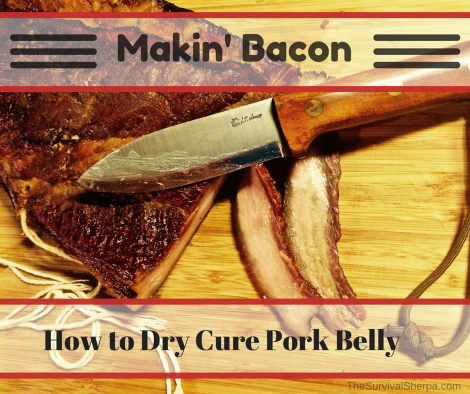

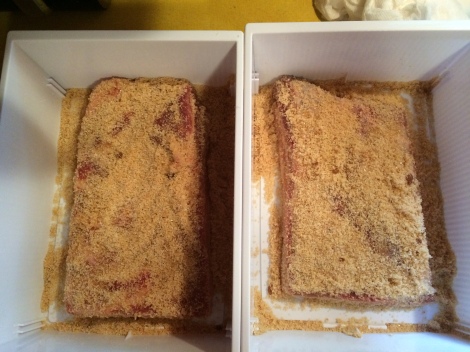

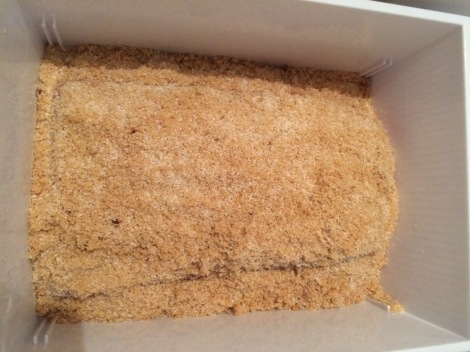
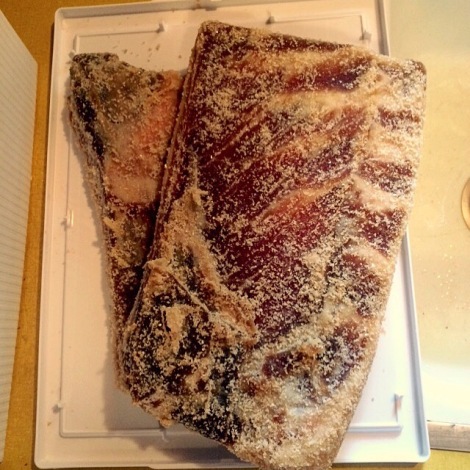

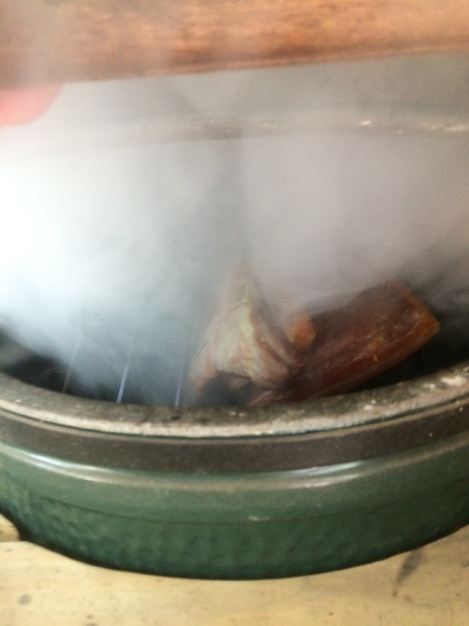


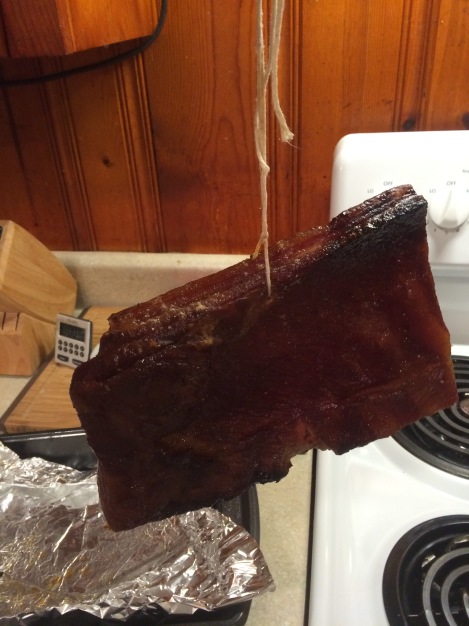








Pingback: Prepper News Watch for June 26, 2015 | The Preparedness Podcast
Thanks for an AWESOME post. You really nailed it about vegetarians. I’ve been working at becoming vegetarian and kosher. All of a sudden I thought I would die without bacon. For the most part, bacon is the only meat I eat. It is filling and energizing and never upsets my stomach like other meats do.
I have a question or two. In the days before salt and sugar could be purchased, how was meat cured? This would be more than a few hundred years back. Way back.
Is there anything else that can be preserved with this curing process?
In a TEOTWAWKI situation, we could continue to raise pigs but what happens when the salt and sugar run out?
Thank you very much for considering my questions. I am definitely reconsidering vegetarianism. Bring on the bacon!
LikeLike
Ah yeah, I knew the bacon would convert ya 😉
Wars have been fought over salt, Karen. It’s such an important resource to stock up on. Of course, food stocks will eventually run out. Being a producer of salt in a long-term event and you’d be set for all manner of barter.
I know of some folks that have extracted salt from sea water. A laborious process for sure. Then there are salt mines where we get most of our salt today.
Smoking meat is another alternative to preserving meat. I’ve done a bit of smoke preservation myself. That would be my option if my salt and sugar ran out.
Thanks for reading and your thought-provoking comment, Karen! And welcome to the bacon club!
LikeLike
Pingback: Survival Sunday - 6/28/2015 - The Prepared Ninja
2 questions if I may. You are not using standard iodized table salt correct? Second are you using any type of curing salt such as Morton cures ? Thanks for the great write up!
LikeLike
Nope, used some standard table salt (non-iodized) and course table salt in the 3 lb. box and brown sugar. No other salts.
Thanks, Bob!
LikeLike
Could you use a pork belly that has been frozen
LikeLike
Never tried it but I don’t see why not. If you do, let us know how it goes, please.
LikeLike
Thank you!
LikeLike
What about using honey in place of the sugar? THAT would have been around centuries ago… Are there any specific changes needed if using honey?
LikeLike
Hi Carol, honey is a meat preservative and is used as a “wet” cure… typically mixed in a wet brine of salty water. I’d have to do more research to come up with the procedure though. Hope this helps.
Thanks for reading and your support!
Todd
LikeLike
Great article! My hubby & I have been talking about trying to make bacon, so I’ll be sharing this article with him. My question is how many days did you let your slabs of bacon hang before cutting and freezing?
LikeLike
Thanks for stopping by and your interest in self-reliance, Marcie! You want to salt the meat until all moisture is gone or stops soaking into the dry cure mix. For mine, it took 13 days plus one for insurance. Brian, my instructor, only cured for 12 days. It varies. The important part is to make sure all the moisture stops existing the meat.
Please keep us posted on your bacon making and let me know if we can help.
Todd
LikeLike
*ahem*
The question was about how long you need to hang the already cured & smoked bacon, not how long you cured it…
I would like to know the answer to that question too…
LikeLike
Sorry about that response. That’s what I get for responding before my coffee is ready.
The meat can hang for several months to dry. I’ve still got a slab hanging right now. I’ll freeze it this week though. As it dries, I’ve noticed a hard crust forming on the slab. This helps prevent bacteria from entering.
Hope that answers your questions.
Todd
LikeLike
Pingback: How Homesteading and Prepping are Alike
Pingback: 27 Basecamp Projects Guaranteed to Elevate Skills and Fun in the Woods | Survival Sherpa
I would be worried about hanging bacon cured this way unrefridgerated. Without nitrite, you run the risk of botulism if it isn’t as dry as jerky. Botulism grows in anaerobic, moist environments (such as the center of a pork belly) which is why nitrite (traditionally saltpeter) is added to bacon. I guess it comes down to how dry are you really getting your pork before leaving it unrefridgerated?
I would have no qualms so long as it stays cold, though.
LikeLike
Pingback: Knowledge vs. Knowing: 37 Woodlore Lessons | Survival Sherpa
Pingback: How to Bushcraft a Hollow Log Crawfish Trap | Survival Sherpa
Pingback: How to Bushcraft a Hollow Log Crawfish Trap | Prepper's Survival Homestead
Pingback: My Top 4 Most Useful Basecamp Builds | Survival Sherpa
How long did you hang the cured slabs to dry (in the pillow cases)?
LikeLike
They can hang several weeks. I used one side of bacon on a camping trip after only a week. The remaining slab went into the freezer a few weeks later for longer term storage.
LikeLike
We use to put our pork in a wooden barrel with the brine which had Salt peter added to it, and checked it every other day at which time we rolled it over bringing the pieces on the bottom to the top, this lasted for approximately two weeks in a cool shed then was taken out and rinsed of then hung in our wooden smoke house and smoked with green poplar for approximately another week or better. The pork at this point had a dry crust on the out side and was moved to the Ice house as we had no other form of refrigeration at that time. This made Delicious hams and bacon.
LikeLike
Thanks for sharing this with us, William.
LikeLike
What if you don’t have a refrigerator a cool dry place to hang it
LikeLike
could you make a salami this way i guess you would use casing for your ground meats and spices but could you dry it and cure same process? same technique? can’t wait to try to make my own bacon! Do you have a great technique to make pastrami?
LikeLike